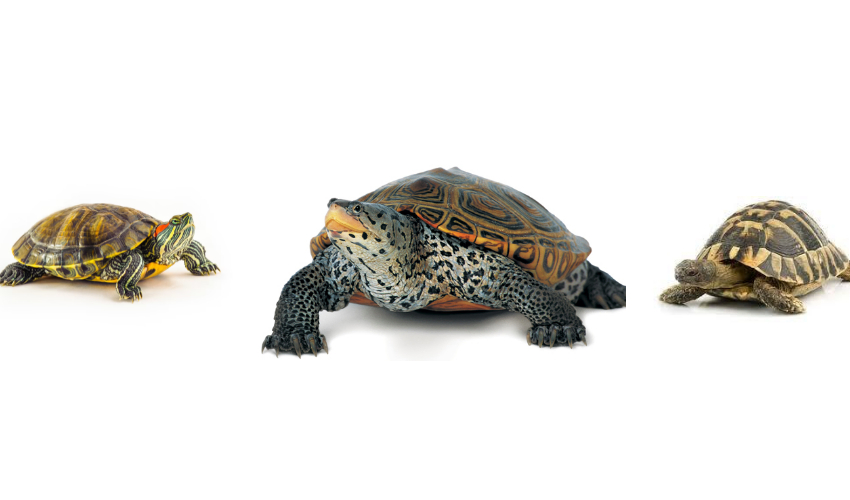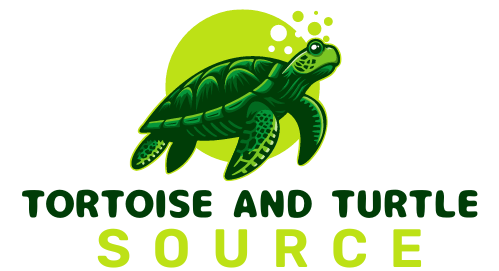
All turtles, tortoises, and terrapins are reptiles. Scientists often refer to them as chelonians because they are in the taxonomic order called Chelonia, from the Greek word for tortoise. They all have scales, lay eggs, and are ectothermic. Chelonians vary in size from fitting in your hand to about 1,800 pounds (817 kilograms). They live everywhere from deserts to oceans to backyard creeks. So, why are there different names? These common names usually refer to differences in where the reptiles live and how they use their habitat. Here are some generally accepted differences between the types of chelonians.
Turtle
Turtles spend most of their lives in the water. They tend to have webbed feet for swimming. Sea turtles, belonging to the Cheloniidae family, are especially adapted for an aquatic life. Long feet that form flippers and a streamlined body shape aid their swimming. Sea turtles rarely leave the ocean, except when females come ashore to lay their eggs. However, some, such as the green sea turtle, come out on reefs and beaches to bask. Other turtles live in freshwater, like ponds and lakes. They swim but also climb out onto banks, logs, or rocks to bask in the sun. In cold weather, they may burrow into the mud, where they go into torpor until spring brings warm weather again.
Tortoise
A tortoise is a land-dweller that eats low-growing shrubs, grasses, and even cactus. Tortoises do not have webbed feet; their feet are round and stumpy for walking on land. Those that live in hot, dry habitats use their strong forelimbs to dig burrows. When it’s too hot in the sun, they slip underground. Tortoises are not adapted for an aquatic lifestyle.
Terrapin
Terrapins spend time both on land and in water, but they always live near water, along rivers, ponds, and lakes. They are often found in brackish, swampy areas. The word “terrapin” comes from an Algonquian word for turtle. They exhibit a mix of aquatic and terrestrial behaviors.
Differences Between Turtles, Tortoises, and Terrapins
| Feature | Turtle | Tortoise | Terrapin |
|---|---|---|---|
| Habitat | Primarily aquatic (oceans, ponds, lakes) | Terrestrial (land) | Both land and water (near rivers, ponds, lakes) |
| Feet | Webbed for swimming | Round and stumpy for walking | Mix of webbed and non-webbed |
| Diet | Varies (omnivorous or herbivorous) | Herbivorous (shrubs, grasses, cactus) | Omnivorous (varies) |
| Shell Structure | Streamlined for swimming | Domed and heavy | Intermediate between turtle and tortoise |
| Movement | Swims and basks in sun | Walks on land, digs burrows | Moves between water and land |
| Special Adaptations | Long flippers (sea turtles), burrowing in mud (freshwater turtles) | Strong forelimbs for digging | Adapted for brackish environments |
| Temperature Regulation | Ectothermic | Ectothermic | Ectothermic |
| Size Range | Hand-sized to 1,800 pounds (817 kg) | Generally smaller than turtles | Intermediate size |
| Notable Behavior | Migrates long distances (sea turtles), basking in sun (freshwater turtles) | Burrowing, escaping heat by going underground | Lives in brackish areas, mixes time on land and water |
| Shell Flexibility | Less flexible (except leatherbacks) | Rigid but lightweight with air chambers | Intermediate flexibility |
Unique Characteristics of Chelonians
Turtles and tortoises are a very old group of reptiles, going back about 220 million years. Of all wildlife with backbones, turtles are the only ones that also have a shell. The shell is made up of 59 to 61 bones covered by plates called scutes, which are made of keratin like human fingernails. A turtle cannot crawl out of its shell because the shell is permanently attached to the spine and the rib cage. The shell’s top is called the carapace, and the bottom is the plastron. Turtles can feel pressure and pain through their shells, just as humans can feel pressure through fingernails.
Hidden-Necked and Side-Necked Turtles
Some turtles can pull their heads, legs, and feet inside their shells; they are known as “hidden-necked turtles.” In order to make room inside the shell, they sometimes have to exhale air out of their lungs, which makes a hissing sound. Other turtles can’t pull their legs or heads into their shells. Some of these have long necks and protect their heads by tucking them sideways into the shell. They are known as “side-necked turtles.” Tortoise shells aren’t as heavy as you might think. The shell contains many tiny air chambers, making it a little lighter.
Leatherback and Softshell Turtles
Leatherback sea turtles and softshell turtles have a rounded, flattened carapace. The entire shell is covered with tough, leathery skin supported by tiny bones. The shell’s bone elements are reduced, making the shell flexible for swimming and diving. Leatherback turtles dive up to 3,000 feet (900 meters) below the ocean surface. At this depth, the incredible water pressure would crush a turtle with a heavy shell and less flexible body.
Sensory Abilities
Turtles and tortoises do not have ears like humans, but they can feel vibrations and changes in water pressure. These sensations tell them where food or a predator might be. They have a good sense of smell, which helps them find food. The skin of a turtle or tortoise, especially the land tortoises, may look leathery and tough. However, it is actually very sensitive. Wildlife care specialists at the San Diego Zoo have found that the Galápagos tortoises seem to enjoy having their necks rubbed.
Unique Abilities
Some turtles seem to have senses or instincts that are not fully understood. Tracking equipment shows that some sea turtles migrate thousands of miles through the sea on regular routes. They return every two or three years to the same beaches to lay their eggs. Aquatic turtles have some unique abilities that allow them to stay underwater. Some can pump water in and out of their mouth and throat, where the rich lining of blood vessels takes oxygen directly from the water. Some turtles can stay submerged for days at a time by moving water in and out of their cloaca to gain oxygen. They are known in Australia as “bum breathers.” Large, webbed, paddle-like feet allow aquatic turtles to push through the water with ease. The Fly River turtle is the only freshwater turtle with true flippers like those of ocean-dwelling turtles.
